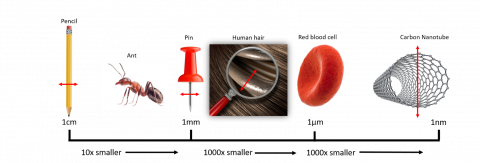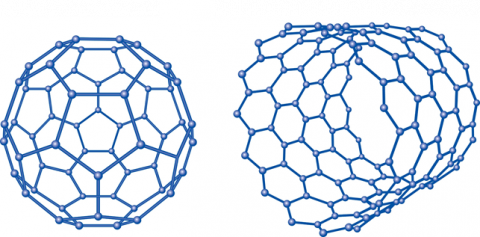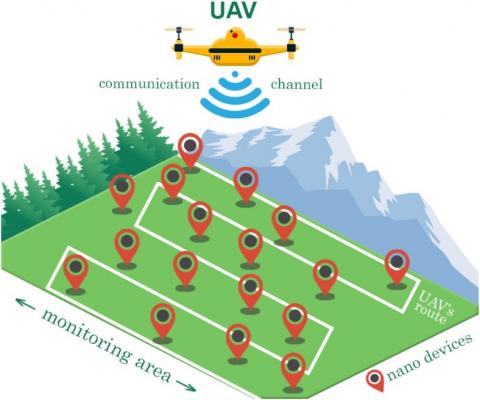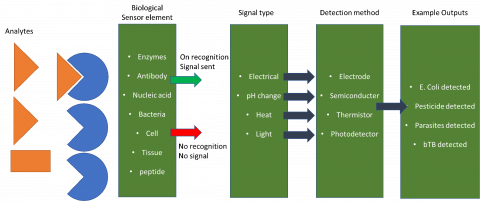12 October 2020
Dr David Cutress: IBERS, Aberystwyth University.
- Nanotechnology is already playing roles in modern agriculture and could have further implementation in the future
- More research is needed to determine the environmental impacts of specific usage of nanomaterials and technologies within agriculture
- If risks can be mitigated nanotechnologies could play an important role in improving agricultural efficiency and sustainability
What is nanotechnology?
Nanotechnology is generally defined as the manipulation of matter with at least one dimension sized from 1 to 100 nanometres (nm). It is often associated with sci-fi movies and literature and has been a concept in fiction from as far back as the 1930s with acclaimed author Sir Arthur Clarke (co-writer of 2001: A Space Odyssey) describing machines that operated in the micrometre scale in his 1956 short story ‘The Next Tenants’. Within the realms of authentic science, the discovery of fullerenes in 1985, such as the carbon Buckminsterfullerene, a staple of GCSE level science lessons, led to subsequent work on carbon nanotubes and the suggestion of designing nanoscale electrical technologies. As an active field of research nanotechnologies demonstrated increased attention from the 2000s onwards with the development of the government research and development (R&D) programme the national nanotechnology initiative (NNI) in the US, swiftly followed by similar government subsidised initiatives globally, including £90 million investments through the Micro and Nanotechnology (MNT) Network in the UK in 2003. Global revenues from nanotechnology products exceeded $700 billion in 2012 with many believing that nanotechnology could be the most significant area of scientific advancement in the next century, demonstrating equivalent impact levels to those seen by oils, polymers and semiconductors in the previous century. Despite this, however, initial forecasts of the nanotechnology markets were slowed by the financial crisis of 2008 including a drop in government initiative investments, though large corporations continued to increase R&D investments. Despite not living up to the initial hype, nanotechnologies continue to have areas of note, with the largest share of the global nanotechnology market being split between electronics, energy and biomedical advancements. Other important aspects of nanotechnologies with relevance in the current climate are the role of nanoparticles as antigen delivery tools in vaccine development, with the first vaccine candidate launched into clinical trials for COVID-19 being delivered via lipid nanoparticles. There has also been an emergence of a role for nanotechnologies within the agricultural sector in various forms which will be discussed below.
Nanotechnology in agriculture
Potential benefits of nanotechnologies in the agricultural sector are thought to include; reducing environmental impacts of farming practices, improving food security, and vitally improving productivity. In the last five years the level of research output surrounding nanotechnology and agriculture has increased by almost three fold, highlighting the growing interest in the field (based on figures from webofknowledge.com).
Nanoparticles
Fertilisers and growth enhancement
A huge factor in the success of food growing (be it crop-based or livestock-based) is the application of nutrients to allow for productive growth. In crops this involves the application of organic or inorganic fertilisers into soils, however, with recent shifts in perspectives towards sustainable farming, fertiliser application has become a key target area for reducing waste and associated negative environmental impacts. Some initial progress towards this goal can be seen in the development of slow-release and controlled-release fertilisers (SRF and CRF respectively) where nutrients are supplied in a less readily available form for plant uptake. As such nutrients stay in the soil for longer and are less affected by leaching. Many CRFs are even specifically designed to release nutrients at rates to loosely match patterns of requirements of specific crops though currently, the costs are prohibitive to many. Nanofertilisers act to continue this innovative approach to nutrient application delivering nutrients to crops encapsulated or coated in nanomaterials or as part of a nanoscale emulsion. Due to their small size, particles can penetrate seeds and enter root tissues or porous parts of plants and be designed to target specific parts of plants allowing for a targeted sustained release of nutrients on-demand with less loss due to soil leaching and microorganism assimilation (nitrification and denitrification). Many of these are already commercially available such as Nano-gro and Biozar Nano-Fertilizer. Intelligent reactive nanofertilisers have also been suggested, where nanomaterials respond to signals from plants within proximity to releasing contents only when required. Such benefits lead to an overall reduction of the dosage of fertiliser elements needed (N, P and K etc) which can reduce costs to farmers, associated greenhouse gases (GHG) and pollution issues. Carbon nanotubes both single wall and multi wall forms have shown effects on plant growth when incorporated into growing medium including in; seed germination by penetrating thick seed coats and facilitating the uptake of water, in promoting cell growth of root systems in wheat leading to higher biomass production. Furthermore, carbon nanotubes and particularly those assembled into nanosponges have been demonstrated to have absorptive effects on water contaminants so could be included in strategies to reduce leaching impacts further in the future.
Nanopesticides and plant protection
Another key aspect of crop management is providing plant protection to prevent losses. Due to issues with overapplication of many pesticides leading to resistances, increased costs, pollution, and other environmental impacts, this is another area where nanoparticles have been considered. Nanopesticides generally involve the encapsulation of compounds in a nanosphere material and have been demonstrated to have; improved solubility increasing plant uptake and reducing leaching, increased resistance to breakdown which would otherwise reduce efficiency, controlled release of payloads over time and can be designed to have highly specific targeting. Nanoparticles have been demonstrated to offer protection in the forms of nanoinsecticides, nanoherbicides, nanonematicides, nanofungicides and nanoantimicrobials as noted below. As with nanofertilisers, these can lead to reduced dosages and overall application of these compounds leading to decreased costs of production alongside reduced environmental impacts.
|
Area or target organism |
Activity |
Reference |
|
|
Nanoinsecticides |
|||
|
Stored-grain insects specifically cowpea weevil |
Equivalent protective activity being shown with ~20x lower concentrations of treatment after 7 days compared to commercial insecticides |
||
|
Green peach aphids |
Nanoscale treatments effective up to 14 days later compared to 2 days with commercial equivalent |
||
|
White fly and Stem fly |
More effective at lower concentrations with reduced residues on crops and soils compared to non-nano equivalent |
||
|
Nanoherbicides |
|||
|
Non-selective contact herbicide - tested in maize and mustard cultivations |
Equivalent herbicidal activity with reduced toxicity impacts |
||
|
Glyphosate nanoemulsion targeting creeping foxglove, slender button weed and buffalo grass |
Equivalent activity compared to Roundup® despite lower spray deposition suggesting enhanced activity overall |
||
|
Reduce toxicity (non-weed target effects) |
Showed reduced toxicity to two key organisms compared to non-nano equivalent |
||
|
Nanonematicides |
|||
|
Root-knot nematodes - Tomato plants |
Improved protections compared to non-nano equivalent |
||
|
Root-knot nematodes - Tomato plants |
Longer-term protections than non-nano equivalent |
||
|
Pinewood nematode and Root-knot nematode |
More effective at lower concentrations than non-nano equivalent |
||
|
Nanofungicides |
|||
|
Colletotrichum gossypii cotton fungus |
Better activity and longer sustained release characteristics than non-nano equivalent |
||
|
Improvement of hexaconazole using Rhizoctonia solani as test fungus |
Better activity with improved safety/soil nitrifier impact compared to the commercial equivalent |
||
|
Powdery Mildews in cucurbits |
Silver nanoparticles demonstrate inhibition of outbreaks and continued growth and reproduction of fungus |
||
Genetic modification of plants
Genetic modification of crops, whilst a controversial issue in many instances, is one of the fastest adopted areas of the agribiotech industry and offers high potential for targeted improvement of crops. Nanotechnologies have been demonstrated to offer a whole new toolset towards delivering nucleotides (DNA, RNA, siRNA etc) into plant cells in targeted ways with reduced side effects. Research has shown the potential of nanoparticles such as silicon dioxide and nanogold to deliver DNA fragments within plants cells successfully and could be utilised to insert genes to increase pest resistance, drought resistance or many other desired traits. Experimental concepts also suggest it could be possible to use nanoparticles containing double-stranded RNAs (dsRNA) applied to plants to affect specific insect pests that attempt to eat the plant materials, knocking down key genes within the insect leading to their eventual death ,whilst having no direct impact on the plant itself. Finally, CRISPR/Cas9 is hailed as the new ultimate tool for high output plant breeding and targeted genetic modifications, however, the technology has seen setbacks due to a lack of carriers able to deliver the editing complexes as desired within organisms. Nanoparticles have been highlighted as a possible tool towards achieving specific cell targeting which could increase the future possibilities of this technology.
Soil specific impacts
Hydrogels, nanoclays and nanozeolites have been suggested to have a role in improving the water-holding capacity of soils. These could facilitate improved water storage and slow release during periods of water shortages as well as up to 50% reductions of nitrogen leaching and 45% reductions of runoff. The extent of such improved water holding improvement has led to possible utilisation of deserts for growing crops or biofuels, taking previously unfarmable habitats and enabling their use. This has huge potential in improving global food security for an increasing population and particularly for areas impacted by climate change. Currently, growth in highly sandy soils/desert ridden countries is often reliant on vast energy being utilised to convert saltwater to usable fresh water with significant pollutant effects, for example in the Middle East 85% of the region’s water is used for agricultural purposes. Nanoremediation is also a concept that is gaining traction with the NanoRem project run by the European Commission suggesting several interesting selling points. Such nanoparticle applications could be incorporated into agricultural soils to improve groundwater quality improving a farm’s environmental impact with several products noted to be on their way to commercialisation.
Feed modification and food processing
Nanotechnologies could have potential roles further into the food chain towards extending food shelf life, quality and improving safety through detecting contamination or food spoilage. Smart food packaging is already making use of nanoparticles to release food preservatives in response to environmental changes, decrease gas permeability, self-repair damage, improve biodegradability and including antimicrobial properties. Smart packaging is also already utilising these tools in combination with nanosensor and nanobiosensor elements, these will be discussed below. Food components themselves, milk proteins or starch components, have also been used to construct nano-delivery coatings to facilitate the increased transfer of vitamins or other nutritional supplements in foods. This application could in future be incorporated into animal feeds to improve the efficiency of uptake of key nutrients. Whey protein and soybean extract are noted for roles in the production of nanoparticles which could offer an increased market for farmers farming these crops in future. Finally, to improve traceability, particularly when recalling products due to contamination and improve the safety of the food chain as a whole, nanotechnologies have shown promise in producing ‘invisible barcodes’. Technologies for carbon nanotube infused ink can turn printed ink into active RFID tags for scanning. Another methodology is looking into nanometre nickel and gold disks which can encrypt data like a barcode and be scanned.
A fairly unique area of advances is in nanogenerators which could take power from the human body itself from normal body movements (walking, heartbeat, breathing, hand or limb movement) and be used to power nanosensors for health and monitoring which could be adapted to livestock use in future.
Nanosensors and Nanobiosensors
Nanosensors are sensor devices which have at least one element of their sensing components smaller than 100 nm. Nanomaterials have unique electrochemical properties that can be utilised for detection purposes to build such nanosensors. Changes can be detected for example in particle conductivity, based on interaction with other particles (for example ammonia (NO3)) which either strip or donate electrons and this signal can be detected and analysed. Due to their small size, they can interact on single-molecule scales making them highly sensitive and specific able to detect down to 10 parts per million of agriculturally important gases such as carbon dioxide (CO2) in the atmosphere without needing large, heavy, complex and costly equipment. Moreover, most nanosensors are passive meaning they require no battery and harvest energy themselves making them applicable for long-term usage. If this technology is combined with nanotechnology developments towards nanoantennas then these nanoscale devices can also produce high-frequency signals making them able to transmit data wirelessly. Some of the applications considered for nanosensors in relation to agriculture include the monitoring of environments around and inside of plants. They can detect, and potentially directly respond to, stresses such as temperature, water levels, pesticide levels or even pest attacks. Monitoring chemical and physical changes in soils to provide information on moisture, nutrient levels, and temperature for example. Currently, this area within agriculture is in its infancy, however, sensors to detect gases, humidity, temperature, pH and many others are already in development. Furthermore, theoretical applications have been assessed for monitoring field environments using nanosensors in combination with mobile gateways (which provide energy to nanosensors in proximity and receive data from them) which can be mounted on ground vehicles or unmanned aerial vehicles (UAVs) providing highly accurate localised environmental soil information for example.
UAV soil monitoring system using Nanosensors in soil (Pirmagomedov et al 2019)
Nanobiosensors incorporate a biological element to assist their ability to sense and measure desired aspects. These can include peptides, enzymes, antibodies, cells, tissues, and nucleotide structures which are linked to a detection method, often a transducer, to create an electronic signal. Other detection methods can be visible colour change or fluorescent-based responses similar to miniaturised versions of penside testing strips. The benefits of nanobiosensors over traditional biosensors are the possibility of increased sensitivity (detecting single virus particles) as well as the high surface area small scale reactions decreasing the reaction times and sample quantity required, improving result efficiency. For such applications, high levels of research and optimisation has been put into using smartphone integrated systems to gain results, removing the requirement of purchasing specific electronic devices. The simplistic concept of the functionality of the majority of biosensors is represented graphically below.
Issues occur if the biological element interacts with other undesired analytes making a test less specific and subject to false positives/negatives which is why significant optimisation is required. Currently, nanobiosensors are being developed towards an array of targets, including the detection of subclinical ketosis, various forms of influenza, and corn mycotoxins. Furthermore, nanoparticle advances are assisting in the development of lateral flow test strips which can detect multiple different analytes in one test, for example in future a pregnancy test could also give you information on an animal’s parasite infection status, health issues and stress levels from a single blood test within minutes on farm. E-noses and e-tongues also use nanoparticles and have previously been highlighted in media for their roles in “sniffing out cancer” and work by detecting volatile organic compounds. Such technologies have been able to detect bacteria which without treatment would cause spoilage in food and drink products or detect freshness and predict quality in meat. These technologies have also been indicated to have possible roles in evaluating soil health by detecting pollution and evaluating aspects such as moisture and microbial activity.
In food processing and packaging specific nanosensors and nanobiosensors are also incorporated in smart packaging to detect changes in; gas components, temperature, pH, UV exposure and detect pathogens/toxins in stored food that could all be indicative of spoilage or ripeness and can be incorporated into simple colour changing food labels to help reduce food wastage.
Issues surrounding biotechnology application
Whilst many nanotechnologies appear to be a great option for incorporation into agricultural practices they are not without their setbacks, particularly with our current level of understanding. Carbon nanotubes’ shape allows them to penetrate human cells easily, making them a significant toxicity risk. Whilst the direct health effects associated with various carbon nanotube applications are still being researched, it is known that they can damage DNA and cell membranes and cause oxidative stress responses ultimately leading to increased necrosis and cell death. However, initial research suggests that changing their size, length, presence of impurities and how they combine could reduce these risks. As well as health risks there is a significant need for further analysis of the levels of persistence of nanoparticles within the environment, heavy use could lead to a new form of pollution which may have unknown off-target effects on the environment. For example, not enough is known about the plant-microbe interaction effects of nanoparticles and how this could affect nutrient cycling.
Furthermore, few studies have assessed the longer-term risks of nanoparticles within an agricultural system and how the impacts of these could be seen in downstream generations. In a study where tomato plants whose parent plants had been in contact with nanoparticles, it was noted that growth and development were stunted compared to controls. Despite potential issues a recent Q&A article with the director of the National Institute of Food and Agriculture (NIFA) in the US suggests that these technologies are still seen as promising for their potential application within agriculture and food production.
Summary
Nanotechnologies within the agricultural sector are in their infancy with a lack of transferability to farm level applications currently. Despite this, these technologies have the potential to provide efficient, compact, and more eco-friendly agrochemicals to assist farmers in maintaining or increasing their production levels. Nanosensors and nanobiosensors could offer a unique way to improve the efficiency of real-time monitoring of various field, plant or animal statuses, with a huge amount of pathogen, disease and health-related advances in human medicinal biotechnology being adaptable for livestock use in the future. Whilst production and manipulation of nanoparticles can be difficult, with manufacturing having associated climate and cost impacts, much research is being undertaken into utilising bacteria, fungi and plants themselves as biological factories to produce nano-formulations in a cost-effective and more sustainable eco-friendly manner.





